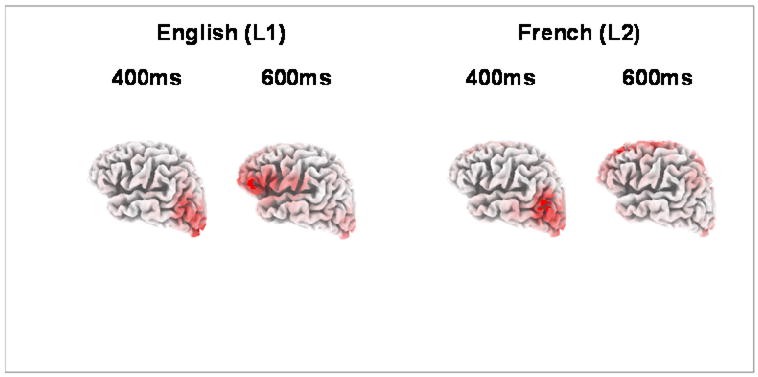Does Learning A Second Language Change Brain Structure? Absolutely! LEARNS.EDU.VN delves into the fascinating world of how acquiring a new language can reshape your brain, enhancing cognitive abilities and creating new neural pathways. Explore the transformative effects of bilingualism, cognitive enhancement, and neural plasticity, all while discovering resources to aid your language learning journey. Unlock your brain’s potential through language acquisition and cognitive development.
1. How Does Second Language Learning Impact Brain Structure?
Learning a second language has a profound impact on brain structure, leading to measurable changes in gray matter and white matter. According to a study from Lund University, learning a new language can increase the size of specific brain areas like the hippocampus and cerebral cortex. This brain adaptation is a testament to neuroplasticity, the brain’s ability to reorganize itself by forming new neural connections throughout life.
1.1. What Specific Brain Regions Are Affected?
Several brain regions are particularly susceptible to change when learning a second language. These include:
- Hippocampus: Involved in memory formation and spatial navigation. Studies, including those from University College London, have shown increased gray matter density in the hippocampus of language learners.
- Cerebral Cortex: Responsible for higher-level cognitive functions. Research indicates that language learning can thicken the cerebral cortex, improving cognitive processing.
- Broca’s Area: Crucial for speech production. Learning a new language can enhance the efficiency of this area.
- Wernicke’s Area: Vital for language comprehension. Studies suggest that increased activity and structural changes occur in Wernicke’s area during language acquisition.
1.2. How Does Age Affect These Changes?
While the brain’s plasticity is most pronounced in childhood, adults can still experience significant structural changes when learning a second language. Research from the University of Edinburgh demonstrates that adults show similar neuroplasticity effects, although the rate and extent of change may vary.
2. What Are the Cognitive Benefits of Bilingualism?
Bilingualism offers numerous cognitive benefits, enhancing mental flexibility, problem-solving skills, and multitasking abilities. Research consistently shows that bilingual individuals often outperform monolinguals in cognitive tasks.
2.1. Enhanced Executive Functions
Bilingual individuals exhibit enhanced executive functions, which include:
- Working Memory: Bilinguals often have better working memory capacity, allowing them to hold and manipulate more information simultaneously.
- Cognitive Flexibility: The ability to switch between tasks or mental sets is improved in bilinguals due to constant language switching.
- Attention Control: Bilinguals demonstrate superior attention control, enabling them to focus on relevant information and filter out distractions.
These benefits are supported by studies from institutions like Northwestern University, which have shown that bilingualism strengthens the brain’s executive control system.
2.2. Delayed Onset of Dementia
Perhaps one of the most compelling benefits of bilingualism is its potential to delay the onset of dementia. A study published in Neurology found that bilingual individuals experienced the onset of dementia an average of 4.5 years later than their monolingual counterparts.
2.3. Improved Problem-Solving Skills
The constant mental juggling required to switch between languages enhances problem-solving skills. Bilinguals often show greater creativity and a more flexible approach to problem-solving, as highlighted in research from the University of Ghent.
3. How Does Language Learning Enhance Neuroplasticity?
Neuroplasticity, the brain’s ability to reorganize itself by forming new neural connections, is significantly enhanced through language learning. This process allows the brain to adapt to new experiences and information.
3.1. Formation of New Neural Pathways
Learning a new language requires the brain to create new neural pathways to process unfamiliar sounds, grammar, and vocabulary. This constant neural activity strengthens these pathways over time. According to a study in Brain and Language, the more proficient you become in a second language, the stronger these neural connections become.
3.2. Strengthening Existing Connections
In addition to forming new pathways, language learning strengthens existing connections in the brain. This reinforcement leads to improved cognitive functions and overall brain health.
3.3. Increased Gray Matter Density
Several studies using voxel-based morphometry (VBM) have demonstrated that language learning leads to an increase in gray matter density in various brain regions. As noted in a study from University of Quebec, this increase is directly correlated with language proficiency.
4. What Are the Best Methods for Language Learning to Maximize Brain Changes?
To maximize the brain changes associated with language learning, it’s essential to adopt effective learning methods that engage multiple cognitive processes.
4.1. Immersion Programs
Immersion programs, which involve surrounding yourself with the language and culture, are highly effective. These programs force the brain to actively process and use the new language in real-world contexts. Research from Middlebury College Language Schools supports the effectiveness of immersion for rapid language acquisition and brain adaptation.
4.2. Active Recall and Spaced Repetition
Active recall, the process of retrieving information from memory, and spaced repetition, which involves reviewing material at increasing intervals, are powerful techniques. These methods strengthen neural connections and improve long-term retention. Tools like Anki are excellent for implementing spaced repetition.
4.3. Interactive Learning
Interactive learning, which includes speaking, listening, reading, and writing, engages multiple brain regions. Engaging in conversations, watching foreign films, and reading books in the target language can significantly enhance learning outcomes. Language learning apps like Duolingo and Babbel incorporate interactive elements to make learning more engaging.
4.4. Combining Methods
The most effective approach often involves combining multiple learning methods. For example, combining immersion with active recall and interactive learning can lead to significant and lasting brain changes.
5. How Can LEARNS.EDU.VN Support Your Language Learning Journey?
LEARNS.EDU.VN offers a wealth of resources designed to support your language learning journey and maximize the cognitive benefits.
5.1. Comprehensive Language Courses
LEARNS.EDU.VN provides comprehensive language courses tailored to various proficiency levels. These courses incorporate interactive lessons, cultural insights, and practical exercises to ensure effective learning.
5.2. Expert Guidance
Our team of experienced language educators offers personalized guidance and support. Whether you’re a beginner or an advanced learner, we provide the resources and expertise you need to succeed.
5.3. Community Support
Join our vibrant community of language learners to connect with like-minded individuals. Share your experiences, ask questions, and find motivation as you progress on your language learning journey.
5.4. Personalized Learning Plans
LEARNS.EDU.VN offers personalized learning plans designed to fit your unique learning style and goals. Our adaptive platform adjusts to your progress, ensuring you stay challenged and engaged.
5.5. Up-to-Date Educational Trends
Staying current with educational trends is crucial in today’s fast-paced world. At LEARNS.EDU.VN, we provide access to cutting-edge methods and resources that enhance the learning experience. Here’s an overview of some current trends:
| Trend | Description | Benefits | Resources on LEARNS.EDU.VN |
|---|---|---|---|
| Microlearning | Delivering content in small, easily digestible segments. | Improved retention, better engagement, and flexibility. | Short, focused lessons and modules. |
| Gamification | Incorporating game-like elements into learning to boost motivation and engagement. | Increased engagement, higher motivation, and a more enjoyable learning experience. | Interactive quizzes, challenges, and rewards systems. |
| Personalized Learning | Tailoring the learning experience to individual needs and preferences. | Better learning outcomes, increased relevance, and higher student satisfaction. | Adaptive assessments and customizable learning paths. |
| Mobile Learning | Using mobile devices to access learning materials anytime, anywhere. | Convenience, flexibility, and access to learning on the go. | Mobile-friendly courses and apps. |
| Virtual and Augmented Reality | Immersive learning experiences that simulate real-world scenarios. | Enhanced engagement, practical application of knowledge, and deeper understanding. | VR/AR simulations for language practice. |
| AI-Powered Learning | Using artificial intelligence to personalize and optimize the learning process. | Personalized feedback, adaptive content, and efficient progress tracking. | AI-driven tutoring and language analysis tools. |
| Project-Based Learning | Learning through hands-on projects that apply knowledge and skills. | Practical skills development, improved problem-solving abilities, and deeper understanding. | Project assignments and collaborative projects. |
| Collaborative Learning | Learning in groups to share knowledge, solve problems, and support each other. | Enhanced communication skills, peer support, and diverse perspectives. | Group projects and discussion forums. |
| Flipped Classroom | Students learn content at home and use class time for interactive activities and discussions. | Deeper engagement, better understanding, and more personalized interaction with instructors. | Pre-recorded lectures and in-class activities. |
| Data-Driven Learning | Using data analytics to track student progress and improve learning outcomes. | Informed decision-making, personalized interventions, and optimized learning strategies. | Performance tracking and personalized recommendations. |


6. What Are the Ethical Considerations in Neurological Research on Language Learning?
As we delve deeper into understanding how language learning affects the brain, it’s crucial to consider the ethical implications of neurological research.
6.1. Informed Consent
Ensuring participants fully understand the purpose, procedures, and potential risks of neurological research is paramount. This includes obtaining informed consent from all participants, particularly vulnerable populations.
6.2. Privacy and Data Security
Protecting the privacy and confidentiality of participants’ data is essential. Researchers must adhere to strict data security protocols to prevent unauthorized access and misuse of sensitive information.
6.3. Equitable Access to Benefits
Ensuring that the benefits of neurological research, such as improved language learning methods, are accessible to all individuals, regardless of socioeconomic status or geographic location.
6.4. Cultural Sensitivity
Respecting cultural differences and values in research design and implementation. This includes being mindful of how language and cultural background may influence cognitive processes and brain structure.
6.5. Transparency and Openness
Promoting transparency in research methods and findings. This includes publishing research results in open-access journals and sharing data with other researchers to facilitate further investigation.
7. What Future Research Is Needed in This Field?
While significant progress has been made, further research is needed to fully understand the complex relationship between language learning and brain structure.
7.1. Longitudinal Studies
Conducting more longitudinal studies to track brain changes over extended periods. This will provide valuable insights into the long-term effects of language learning.
7.2. Diverse Populations
Expanding research to include diverse populations, including individuals with different linguistic backgrounds and learning abilities. This will help generalize findings and identify individual differences.
7.3. Advanced Neuroimaging Techniques
Utilizing advanced neuroimaging techniques, such as diffusion tensor imaging (DTI) and functional MRI (fMRI), to gain a more detailed understanding of brain connectivity and function during language learning.
7.4. Intervention Studies
Designing intervention studies to test the effectiveness of specific language learning methods on brain structure and cognitive function. This will help identify the most effective strategies for maximizing brain changes.
7.5. Integration of Disciplines
Fostering collaboration between neuroscientists, linguists, and educators to integrate knowledge and develop comprehensive models of language learning and brain plasticity.
8. How Can Technology Enhance the Brain Changes Associated with Language Learning?
Technology plays a crucial role in enhancing the brain changes associated with language learning by providing personalized, interactive, and immersive experiences.
8.1. Language Learning Apps
Language learning apps such as Duolingo, Babbel, and Rosetta Stone offer interactive lessons, gamified exercises, and personalized feedback. These apps engage multiple brain regions and promote active learning.
8.2. Virtual Reality (VR)
VR technology creates immersive environments that simulate real-world language learning scenarios. VR simulations allow learners to practice speaking and listening skills in a safe and engaging setting.
8.3. Artificial Intelligence (AI)
AI-powered language learning tools provide personalized feedback, adaptive content, and intelligent tutoring. AI algorithms analyze learner performance and adjust the learning path to optimize progress.
8.4. Brain-Computer Interfaces (BCIs)
Emerging BCI technology has the potential to enhance language learning by directly stimulating brain regions associated with language processing. While still in its early stages, BCI research shows promise for accelerating language acquisition.
8.5. Online Language Communities
Online language communities and social media platforms provide opportunities for learners to connect with native speakers, practice their skills, and receive feedback. These interactions promote social learning and cultural exchange.
9. How Do Different Languages Affect Brain Structure Differently?
The specific brain changes associated with language learning may vary depending on the linguistic features of the target language.
9.1. Tonal Languages
Learning tonal languages, such as Mandarin Chinese, requires heightened auditory processing skills. Research suggests that learning tonal languages can increase gray matter density in auditory cortex regions.
9.2. Grammatical Complexity
Languages with complex grammatical structures, such as German, require extensive cognitive effort. Learning these languages may lead to greater changes in brain regions associated with syntactic processing.
9.3. Script Differences
Learning languages with different scripts, such as Japanese or Arabic, requires visual processing and motor skills. These languages may lead to changes in visual cortex and motor cortex regions.
9.4. Phonetic Inventory
Learning languages with a large phonetic inventory, such as Hindi, requires discrimination of a wide range of sounds. This may lead to changes in auditory cortex regions.
9.5. Cultural Context
The cultural context of a language can also influence brain structure. Learning a language associated with a rich cultural heritage may lead to changes in brain regions associated with social cognition and empathy.
10. How Does Bilingualism Protect Against Cognitive Decline?
Bilingualism has been shown to protect against cognitive decline by enhancing cognitive reserve, which is the brain’s ability to cope with damage or disease.
10.1. Increased Cognitive Reserve
Bilingualism increases cognitive reserve by strengthening neural connections and enhancing cognitive functions such as executive control and working memory.
10.2. Enhanced Brain Plasticity
Bilingualism promotes lifelong brain plasticity, allowing the brain to adapt and reorganize itself in response to age-related changes.
10.3. Delayed Onset of Dementia
As mentioned earlier, bilingualism has been shown to delay the onset of dementia by several years. This is likely due to the increased cognitive reserve and enhanced brain plasticity associated with bilingualism.
10.4. Improved Cognitive Performance
Bilinguals often maintain better cognitive performance throughout their lifespan compared to monolinguals. This is likely due to the constant mental exercise and cognitive demands of managing multiple languages.
10.5. Protection Against Brain Damage
Bilingualism may also provide protection against the effects of brain damage. Studies have shown that bilinguals recover more quickly and completely from stroke and other brain injuries.
Learning a second language is more than just acquiring new vocabulary and grammar; it’s a transformative experience that reshapes your brain, enhances cognitive abilities, and opens up new opportunities for personal and professional growth. At LEARNS.EDU.VN, we’re committed to providing you with the resources and support you need to unlock your brain’s potential and embark on a successful language learning journey.
Ready to transform your brain and unlock new possibilities? Visit LEARNS.EDU.VN today to explore our comprehensive language courses, expert guidance, and vibrant community of learners. Contact us at 123 Education Way, Learnville, CA 90210, United States, or reach out via Whatsapp at +1 555-555-1212. Let LEARNS.EDU.VN be your partner in achieving your language learning goals!
FAQ: Frequently Asked Questions About Second Language Learning and Brain Structure
1. Does learning a second language change the physical structure of the brain?
Yes, studies show that learning a new language can increase gray matter density and alter neural pathways in the brain.
2. Which parts of the brain are most affected by learning a second language?
Key areas include the hippocampus, cerebral cortex, Broca’s area, and Wernicke’s area.
3. Can adults experience brain changes from language learning, or is it just for children?
Adults can absolutely experience significant brain changes through language learning, though the rate and extent may vary.
4. How does bilingualism affect cognitive functions?
Bilingualism enhances executive functions like working memory, cognitive flexibility, and attention control.
5. Is there evidence that bilingualism can delay the onset of dementia?
Yes, research suggests that bilingual individuals may experience the onset of dementia several years later than monolinguals.
6. What are the most effective methods for maximizing brain changes during language learning?
Immersion programs, active recall, spaced repetition, and interactive learning are highly effective.
7. How does LEARNS.EDU.VN support language learners in achieving these brain changes?
learns.edu.vn offers comprehensive courses, expert guidance, community support, and personalized learning plans.
8. Are there ethical considerations in neurological research on language learning?
Yes, informed consent, data privacy, equitable access, cultural sensitivity, and transparency are crucial ethical considerations.
9. What kind of future research is needed in the field of language learning and brain structure?
Longitudinal studies, diverse populations, advanced neuroimaging techniques, and intervention studies are needed.
10. Do different languages affect brain structure differently?
Yes, the linguistic features of a language, such as tonality or grammatical complexity, can lead to different brain changes.
